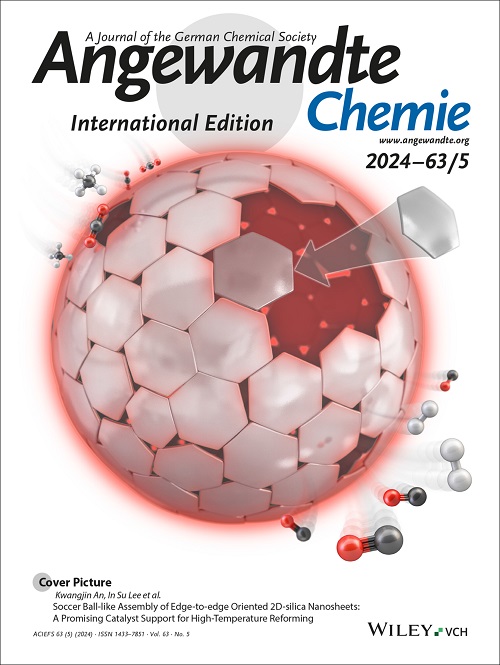From Spiropyran to a Circadian-Responsive Photochromic Supramolecular System for Sustainable Crop Protection: Enhanced Photostability, Biofilm Disintegration, and Foliar Adhesion.
IF 16.9
1区 化学
Q1 CHEMISTRY, MULTIDISCIPLINARY
引用次数: 0
Abstract
Biofilms establish protective sanctuaries that shield resident bacteria, facilitating resistance. Despite extensive efforts, current chemicals for biofilm eradication remain insufficient, with the reliance on single-structure antimicrobials further exacerbating resistance. Photoisomerizable spiropyran derivatives reversibly transition between conformational states, alternately exerting antimicrobial activity against pathogens and potentially mitigating resistance. However, the biofilm-eradicating potential of spiropyran derivatives remains unverified, while their application is hindered by limited fatigue resistance, suboptimal foliar affinity, and reliance on UV-induced isomerization, all of which are incompatible with sustainable agriculture. Herein, we present a supramolecular strategy to fabricate SpA6(MC)⊂CB[8], a self-assembled complex of the spiropyran derivative SpA6 and cucurbit[8]uril, offering day-night cycle isomerization, enhanced photostability, potent biofilm disruption, improved foliar adhesion, and high antibacterial activity. Notably, neither ambient light nor darkness attenuates its potency, enabling persistent antibacterial activity across diverse molecular configurations. In vivo studies demonstrate its superior dual protective/curative efficacy (54.73%/49.60%) at 200 µg mL-1 against bacterial leaf blight, surpassing thiazole copper (37.63%/33.58%) and bismerthiazol (31.20%/25.59%) without compromising safety, while extended indications reveal its enhanced efficacy (78.99%/63.50%) against citrus canker, outperforming thiazole copper (59.50%/41.42%). This work establishes a paradigm for developing light-responsive supramolecular agrochemicals that combine structural dynamism with enhanced functionality, offering sustainable solutions against plant pathogens.从螺吡喃到可持续作物保护的昼夜节律响应光致变色超分子系统:增强光稳定性,生物膜解体和叶面粘附。
生物膜建立了保护避难所,保护细菌,促进耐药性。尽管进行了广泛的努力,但目前用于消灭生物膜的化学物质仍然不足,对单结构抗菌剂的依赖进一步加剧了耐药性。可光异构的螺吡喃衍生物在构象状态之间可逆过渡,交替发挥对病原体的抗菌活性和潜在的减轻耐药性。然而,螺旋吡喃衍生物的生物膜根除潜力尚未得到证实,其应用受到有限的抗疲劳性、次优的叶面亲和性和对紫外线诱导异构化的依赖的阻碍,所有这些都与可持续农业不相容。在这里,我们提出了一种超分子策略来制造SpA6(MC) CB[8],这是一种由螺旋体吡喃衍生物SpA6和瓜类[8]uril自组装的复合物,具有昼夜周期异构化、增强光稳定性、有效的生物膜破坏、改善叶片粘附性和高抗菌活性。值得注意的是,环境光和黑暗都不会减弱其效力,使其在不同的分子结构中具有持久的抗菌活性。体内研究表明,在200µg mL-1浓度下,其对细菌性叶枯病的双重保护/治疗效果(54.73%/49.60%)优于噻唑铜(37.63%/33.58%)和双美噻唑(31.20%/25.59%),且不影响安全性,而扩展适应症显示其对柑橘溃疡病的治疗效果(78.99%/63.50%)优于噻唑铜(59.50%/41.42%)。这项工作为开发光响应超分子农用化学品建立了一个范例,该化学品将结构动力学与增强的功能相结合,为植物病原体提供可持续的解决方案。
本文章由计算机程序翻译,如有差异,请以英文原文为准。
求助全文
约1分钟内获得全文
求助全文
来源期刊
CiteScore
26.60
自引率
6.60%
发文量
3549
审稿时长
1.5 months
期刊介绍:
Angewandte Chemie, a journal of the German Chemical Society (GDCh), maintains a leading position among scholarly journals in general chemistry with an impressive Impact Factor of 16.6 (2022 Journal Citation Reports, Clarivate, 2023). Published weekly in a reader-friendly format, it features new articles almost every day. Established in 1887, Angewandte Chemie is a prominent chemistry journal, offering a dynamic blend of Review-type articles, Highlights, Communications, and Research Articles on a weekly basis, making it unique in the field.

 求助内容:
求助内容: 应助结果提醒方式:
应助结果提醒方式:


